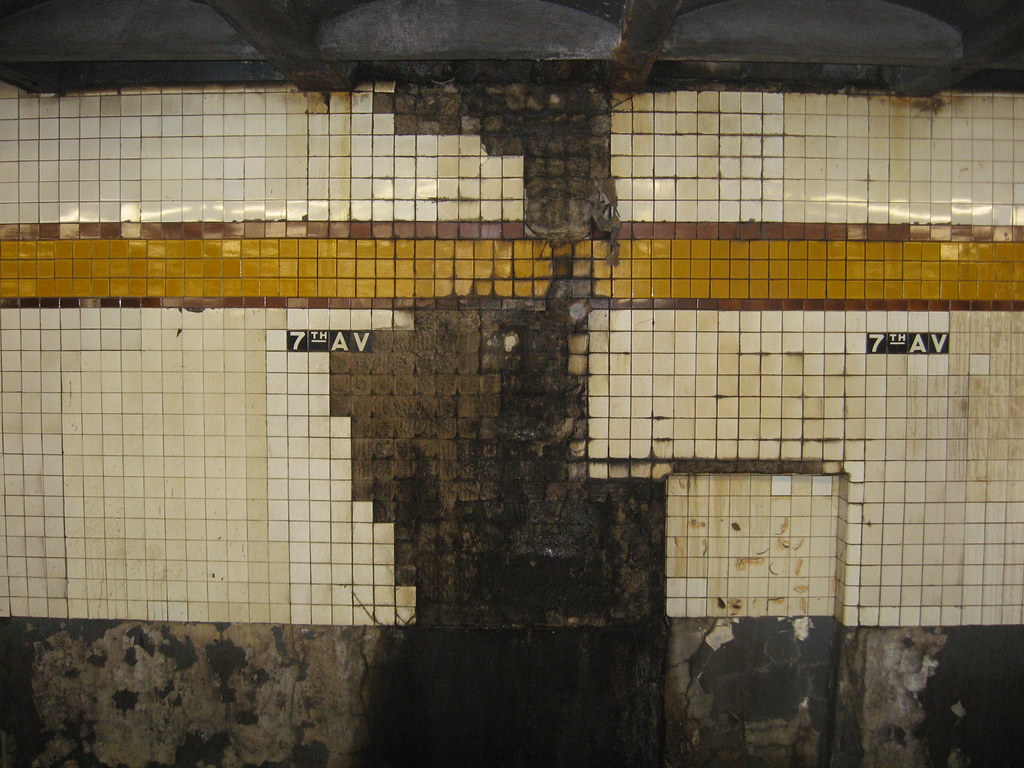The 7th Ave. station on the IND Culver Line would probably pass the MTA’s Eyeball Test. (Photo by Benjamin Kabak)
Generally, I try to give those running the MTA and its subdivision the benefit of the doubt. It’s not easy to oversee a 24/7 transit network that includes three different rail divisions, a whole slew of buses, thousands of track miles and hundreds of stations spread out over 12 counties and parts of two states.
Sometimes, though, news comes along that makes me wonder just what is going on inside the upper reaches of 2 Broadway. Take, for instance, the welcome news that Transit is going to ramp up station inspections in the aftermath of the ceiling collapse at 181st St. I’ve been pushing this angle of the story for the last two weeks, and as a daily rider of the subways, I’m comforted to know that Transit will be making a concerted effort to ensure our collective safety.
That’s not the crazy part. The crazy part is how they used to it. Before Aug. 16, Transit inspectors would employ the “Eyeball Test.” To paraphrase a friend of mine, that’s how I generally assess the security of subway ceilings as well. Anyway, Heather Haddon has both the good and absurd of it:
The MTA will conduct tougher station inspections in the wake of last month’s ceiling collapse at the 181st Street stop on the No. 1 train, transit officials said Tuesday. Engineers are beefing up NYC Transit’s protocol for station inspections to include new technology that can “spot potentially serious latent defects,” transit spokesman Charles Seaton said. Officials yesterday did not further elaborate.
Currently, inspectors primarily eyeball a station to determine its soundness. After the ceiling collapse on Aug. 16, relying on visual inspections is “obviously inadequate,” NYC Transit President Howard Roberts stated in internal communication Friday…
Transit advocates are hoping the MTA will start using devices that can detect water damage through sound waves. Water seepage is believed to have played some role in the ceiling collapse, which knocked out service for two weeks.
So just to recap: The MTA has been assessing the structural integrity of its 105-year-old tunnels by eyeballing a station to “determine its soundness.” Stunningly, it took a chunk of ceiling to fall on the tracks for Howard Roberts to realize just how “obviously inadequate” that method is.
Over the last few years, with some solid leaders in place, Transit and the MTA have made strides to improve their public image. The agency’s finances are far more transparent than they used to be, and Roberts has led an era of improved customer relations for Transit. Still, vestiges of the old ways — of secrecy, of lean times, of barely getting by — still seep through the progress. This is one of those times.
As Transit inspectors fan out to look for those “serious latent defects,” I wouldn’t be surprised if the news about structural problems in the subway system picked up over the next few months. It may be enough to attract more money for transit investment, but somehow, the MTA will have to counteract this new story. After all, if the best test those running our trains have involves just looking at ceiling, I have to wonder how any station passed that test and what the MTA is going to find with its more in-depth examinations.


7 comments
Imagine if your doctor performed an examine by “eyeballing” you.
Er, examination.
Hell I could do an eyeball examination & I’m legally blind!
I wonder what this will do for the many 7 line stations that feel as though they are going to topple over at anytime.
The Court Square station in particular bounces and rocks to the point that it makes the Manhattan Bridge bounce seem like nothing.
This story is almost unbelievable. It took a station ceiling collapse for them to realize an “eyeball” test is “obviously inadequate?”
Now, not only do I have to worry about my loss of hearing, but I have to watch out for falling debris that may have slipped by all the sophisticated “eyeball” testing.
The ceiling at 181st was called out by the MTA a year before the collapse but the request for approval languished in the Capital Plan Review Board for all but the last week. So how again would have more inspection helped fix the problem? Ironically (sometimes there is a fine line between irony and cynicism) the Capital Plan Review Board was set up to provide more “transparency” and “accountability” to the MTA operations.
I’ve heard national news reports that New York officials don’t want restrictions on Wall Street bonuses because taxes on them pay for essential services.
Since we just came off a series of boom years, where was the investment in Subway maintenance? The areas served and frequency of service are amazing. But even an eyeball test tells even the casual observer that structural and other maintenance is not a priority.
Why do you put up with it?